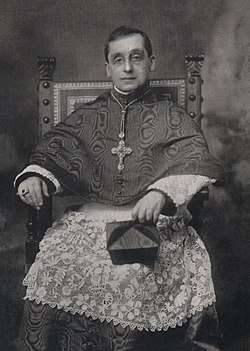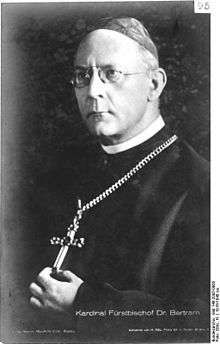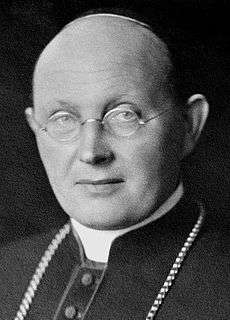Cardinals created by Benedict XV
Pope Benedict XV (r. 1914–1922) created 32 cardinals in five consistories.

6 December 1915
Pope Benedict created six cardinals, five Italians and one Austrian, at a consistory on 6 December 1915. Four had served in the diplomatic corps of the Holy See. Gusmini was Benedict's successor as Archbishop of Bologna. The membership of the College of Cardinals after this consistory included 29 Italians and 32 non-Italians.[1][2]
- Giulio Tonti (1844–1918)
- Alfonso Mistrangelo (1852–1930)
- Giovanni Cagliero (1838–1926)
- Andreas Franz Frühwirth (1845–1933)
- Raffaele Scapinelli di Leguigno (1858–1933)
- Giorgio Gusmini (1855–1921)
4 December 1916

With Europe at war in December 1916, Benedict named ten cardinals, seven Italian and three French. All the cardinals who attended came from one wartime alliance, none from their enemies, Germany and Austria-Hungary. Austrian Cardinal Andreas Frühwirth, who was made a cardinal at the preceding consistory, received his red hat from Benedict a few days earlier.[3] In deference to wartime conditions, Benedict created Adolph Bertram a cardinal in pectore, that is, without his name being announced. Bertram's Polish homeland was fighting alongside Germany and Austria-Hungary against Italy and its allies.
- Pietro La Fontaine (1860–1935)
- Vittorio Ranuzzi de' Bianchi (1857–1927)
- Donato Sbarretti (1856–1939)
- Auguste-René-Marie Dubourg (1842–1921)
- Louis-Ernest Dubois (1856–1929)
- Tommaso Pio Boggiani (1863–1942)
- Alessio Ascalesi (1872–1952)
- Louis-Joseph Maurin (1859–1936)
- Adolf Bertram (1859–1945) created in pectore, announced 5 December 1919[4]
- Niccolò Marini (1843–1923)
- Oreste Giorgi (1856–1924)
15 December 1919
Benedict created six cardinals on 15 December 1919, three Italians, two Poles, and one Spaniard.[5][6] All attended but Juan Soldevilla y Romero, Archbishop of Zaragoza,[5] who received his red hat from King Alfonso XIII of Spain on 25 December. Bertram, created a cardinal in pectore in 1916, participated in this consistory.[5] At the close of this consistory, the College of Cardinals had 63 members, 32 Italians and 31 non-Italians.[7]
- Filippo Camassei (1848–1921)
- Augusto Silj (1846–1926)
- Juan Soldevilla y Romero (1843–1923)
- Teodoro Valfre di Bonzo (1853–1922)
- Aleksander Kakowski (1862–1938)
- Edmund Dalbor (1869–1926)
7 March 1921

Benedict add six prelates to the College on 7 March 1921, two Germans, 2 Spaniards, an American, and an Italian.[8] The names had been announced on 22 February.[9][10]
- Francesco Ragonesi (1850–1931)
- Michael von Faulhaber (1869–1952)
- Dennis Joseph Dougherty (1865–1951)
- Juan Benlloch i Vivó (1864–1926)
- Francisco Vidal y Barraquer (1868–1943)
- Karl Joseph Schulte (1871–1941)
13 June 1921
Benedict named three Italian cardinals at his last consistory. Three others made cardinals the previous March participated, having been first awarded their red hats by the King of Spain: Francesco Ragonesi, Papal Nuncio to Spain, and the Spanish bishops Juan Benlloch i Vivó and Francisco Vidal y Barraquer.[11][12] Italian newspapers reported that Benedict privately told the three new cardinals that "We gave you the red robe of a Cardinal.... very soon, however, one of you will wear the white robe".[13]
- Giovanni Tacci Porcelli (1863–1928)
- Achille Ratti (1857–1939) (Pope Pius XI; 1922–1939)
- Camillo Laurenti (1861–1938)
References
- "The Six New Cardinals". America. XIV (9): 196. 11 December 1915. Retrieved 14 July 2018.
- Edmiston, Homer (10 February 1916). "The Papal Consistory of December 6". The Nation. 102 (2641): 157. Retrieved 14 July 2018.
- "Pope Names Ten Cardinals" (PDF). New York Times. 5 December 1916.
- Lentz III, Harris M. (2009). Popes and Cardinals of the 20th Century: A Biographical Dictionary. McFarland & Company. p. 24. Retrieved 3 December 2017.
- "Pope Bestows Red Hats at a Consistory; Rev. J.G. Murray of Hartford Made a Bishop" (PDF). New York Times. Retrieved 17 July 2018.
- "Sacrum Consistorium". Acta Apostolicae Sedis (in Latin). Typis Polyglottis Vaticanis. XI (14): 485, 487–8. 19 December 1919.
- The New International Year Book. Dodd, Mead and Company. 1920. p. 579. Retrieved 17 July 2018.
- "Consistory in Rome Today on Cardinals" (PDF). New York Times. Associated Press. 7 March 1921. Retrieved 17 July 2018.
- "Names of Six New Cardinals Announced by Vatican Organ" (PDF). New York Times. 23 February 1921. Retrieved 17 July 2018.
- "Chronicle: Rome". America. XXIV (22): 515. 19 March 1921.
- "Six Red Hats Conferred" (PDF). New York Times. 17 June 1921. Retrieved 17 July 2018.
- "Pope Criticizes Jews for Acts in Palestine; Urges Appeal to League to Define Mandate" (PDF). New York Times. Associated Press. 14 June 1921. Retrieved 17 July 2018.
- Aradi, Zsolt (2017). Pius XI: The Pope and the Man. Pickle Partners Publishing. p. . Retrieved 17 July 2018.
- Additional sources
- Lentz III, Harris M. (2002). Popes and Cardinals of the 20th Century: A Biographical Dictionary. McFarland & Company. ISBN 978-0-7864-4101-3.
- Biographical Dictionary of the Cardinals of the Holy Roman Church